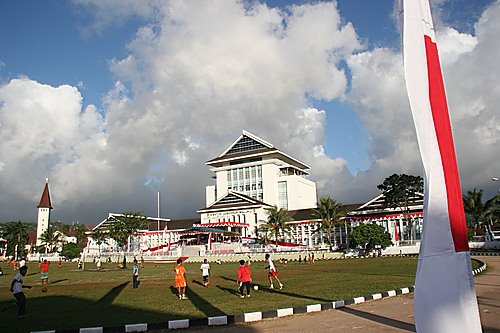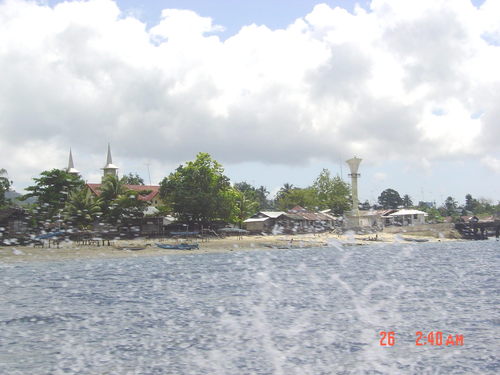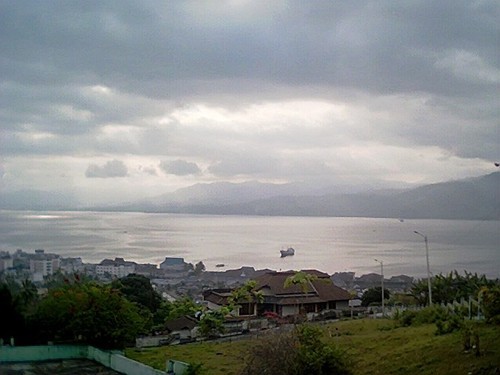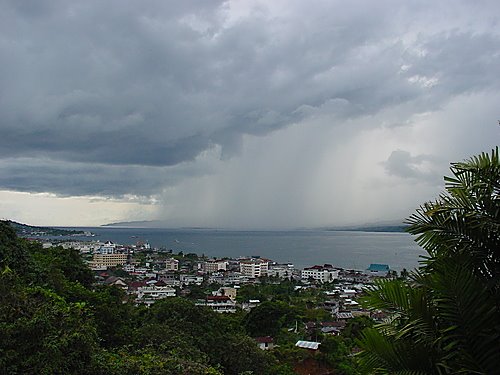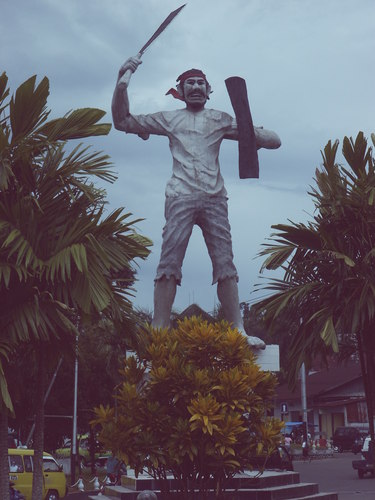Ambon, Maluku
From Wikipedia, the free encyclopedia
Ambon (1990 pop. 275,888) is the main city and seaport of Ambon Island, and is the capital of Maluku province of Indonesia. It is one of the largest cities in eastern Indonesia. The city was the site of some of the worst violence between Christian and Muslim groups that gripped the Maluku archipelago between 1999 and 2002.
Ambon has an airport, and is home to the state-own Pattimura University, a state university, and the Indonesian Christian University of Maluku (UKIM), a private Protestant university, though both were seriously damaged during the violence in 2000-2002.
Contents[hide] |
[edit] History
Ambon was colonized by Portugal in 1526. The Portuguese were driven out by the Dutch in 1609. Except for brief periods of British rule, the island remained under Dutch control until Indonesia's independence in 1945.
During the Dutch period, Ambon was the seat of the Dutch resident and military commander of the Moluccas. The town was protected by Fort Victoria, and a 1911 encyclopedia characterized it as "a clean little town with wide streets, well planted". The population was divided into two classes, orang burger (citizens) and orang negri (villagers), the former being a class of native origin enjoying certain privileges conferred on their ancestors by the old Dutch East India Company. There were also, besides the Dutch, some Arabs, Chinese and a few Portuguese settlers.
On December 22, 1902, the Apostolic Prefecture of Dutch New Guinea was established in the city, later to be promoted as the Diocese of Amboina.
Ambon Island was the site of a major Dutch naval base, captured by the Japanese in 1942. Ambon was a center of Christian missionary activity, and Ambon and the surrounding islands have many Christians as well as the Muslims that predominate in most of Indonesia.
In 1950, Ambon was the center of an uprising against Indonesian rule, caused by the rebellion of Republic of the South Moluccas. Indonesia reasserted control just in few weeks.
[edit] Religious riots
| This section needs additional citations for verification. Please help improve this article by adding reliable references. Unsourced material may be challenged and removed. (October 2007) |
Inter-communal violence between Christians and Muslims ignited in January 1999 after a fight between a Christian bus driver and a Muslim youth broke out on January 19th. Parts of Ambon city were destroyed, including parts of Pattimura University. Violence escalated as several 10,000 Islamist Laskar Jihad fighters from Java joined the fighting. Although there had been no serious incidents prior to 1999, tensions had been simmering between Christians and Muslims, the populations of which are roughly equally proportioned.
The problems were exacerbated by the inability of police and army to keep control. With endemic corruption, sectarian splits and mistrust between the religious groups, both the police and army were accused of joining the violence, and taking sides according to religion and, the area they came from as well. Soldiers of the Indonesian army, many of whom were from Java and Ujung Pandang (in Sulawesi, home of the Buginese, the ethnicity of most Muslims in Ambon), repeatedly allowed large groups of Laskar Jihad fighters to launch their attacks against Christian villages in the vicinity of Ambon. Ambonese Muslims, however, accused the local police of favouring Christians.
Fighting has erupted sporadically since 1999, and many Ambonese have been displaced by the violence. The violence decreased in late 2002, and, aside from a spate of bombings in April 2004, as of January As of 2005[update], the city is relatively peaceful. Laskar Jihad, which was responsible for some of the worst atrocities during the fighting, has since engaged in fighting in other parts of Indonesia, especially in Sulawesi and Western New Guinea (where, again, army collaboration is claimed).
Outsiders are now discouraged from visiting Ambon Island, and the city of Ambon is still partially segregated along religious lines. However, since the peace accord, people from both faiths have seen increasing interaction through trade. Multi-faith schools are re-appearing.
[edit] Places of Interest
- Monument of Pattimura, Lapangan Merdeka
- Monument of Christina Martha Tiahahu, Karang Panjang
- Natsepa beach
- Santai beach
[edit] References
- Ambon rioting leaves 100 dead in Indonesia from World Socialist Website, 30 January 1999
[edit] External links
- Ambon, Maluku is at coordinates Coordinates:



